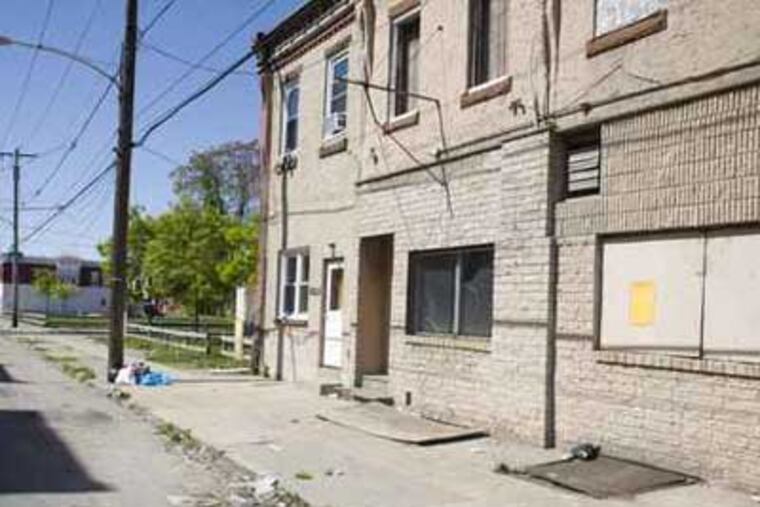Census figures in region show poor getting poorer
The poor got poorer and the well-off didn't get any better in the Philadelphia region in 2009, according to U.S. census figures released Tuesday.

The poor got poorer and the well-off didn't get any better in the Philadelphia region in 2009, according to U.S. census figures released Tuesday.
Philadelphia retained its unwanted position as the poorest among the country's 10 largest cities, with a poverty rate of 25 percent. Making a bad situation worse, the number of children in poverty under age 18 in the city fell to one in three.
Meanwhile, the median income of residents in Philadelphia's better-off suburbs either rose slightly or fell in many places, a clear sign of the sour economy's stranglehold on the region.
At the same time, food-stamp enrollments throughout Philadelphia and its surrounding counties have soared since the recession began in December 2007, figures from Pennsylvania and New Jersey show.
The sober numbers are attributed to both the recession and to an intractable deprivation that has long been part of daily life in the city and parts of the area.
Regional poverty figures echo national census data released earlier this month, which showed the national poverty rate at 14.3 percent in 2009, the highest level since 1994.
"These numbers confirm what we've been seeing on the ground in food pantries, where need is growing both in Philadelphia and in its outlying counties," said Bill Clark, executive director of Philabundance, the region's largest hunger-relief agency.
In Burlington County, the poverty rate increased from 4.7 percent in 2007 to 5.8 percent in 2009. In Chester County, poverty went from 5.4 percent to 6.3 percent during the same period.
The largest percentage-point increase in poverty was in Philadelphia, which grew 1.2 percentage points.
Falling into poverty through recession and unemployment takes a toll.
"It's hard to not be a provider anymore," said Tom Burrell, 51, of Woodlyne, Camden County, a laid-off chef for Camden County Head Start programs.
"You go from $60,000 a year to nothing," said Burrell, who is married and has three children ages 7, 9, and 13. The family takes in $500 a month in welfare and $700 in food stamps, at $14,400 annually an amount well below the poverty level of $25,790 for a family of five.
Burrell volunteers at the Touch New Jersey food pantry in Camden to fill his days and help others.
"It's been such a strain on my marriage," he said. "Things begin to deteriorate. And it's awful watching my children need school uniforms and not be able to buy them."
Along with the census numbers, state figures confirmed growing need around the region, as increasing numbers of people have enrolled in the federal food-stamp program.
While Philadelphia continues to have the highest number receiving food stamps, suburban counties all showed an increase in the number of enrollees.
Some of the increase was attributed to changes in state rules that allow more families to apply for help.
Last fall, eligibility for food stamps increased from 130 percent to 160 percent of the federal poverty level in Pennsylvania. New Jersey changed its eligibility from 130 percent to 185 percent of poverty. The federal poverty level for a family of four is $22,050 annually.
Throughout the area, median income fell or remained roughly the same throughout the recession, emphasizing the tight economic box many people have found themselves in.
In Chester County, which has the region's highest median income, real income dropped 5.3 percent between 2007 and 2009 from $86,031 to $81,495. Bucks showed a 4.2 percent increase to $76,169.
Overall, real median household income in the United States fell between 2007 and 2009 - from $52,501 to $50,221, a drop of 4.3 percent, census figures show.
While the census figures reflect people officially in poverty, there are many more people who make salaries higher than the $22,050 annual poverty level who are still hurting, noted Marianne Bellesorte, director of policy at PathWays PA, an advocacy group for women and children in Holmes, Delaware County.
"Many are really struggling," she said, "moving in with their family, living on half an income instead of two, who still might be bringing in $25,000 or $30,000 a year."
"People need much more than that to survive in Pennsylvania."
Though economists say the recession is over, dismal times remain in the region, said Jerry Birkelbach, executive director of Montgomery County's Department of Economic and Workforce Development.
He said that he has never seen such a wide range of people out of work before.
The good news is that the big layoffs of 2008 and 2009 have subsided, he said. The bad news is that it is taking a long time for people to find jobs - 34 weeks is the average.
"The last 20 months really have been different than the last 20 years," Birkelbach concluded.
In South Jersey, the increasing numbers of poor make it especially difficult for the charities designed to help them.
Not only are the demands on their services greater, but donations have dropped off, said Ujwala Samant, a director with the Food Bank of South Jersey.
The amount of food donated to the food bank decreased by almost 20 percent from this year to last, according to data provided by that agency.
The rough times in the Delaware Valley seem never-ending to some.
"You see what you want for you and your family, but you can't get it," said Emily Edwards, 26, a West Philadelphia part-time receptionist. The mother of a 2-year-old boy, Edwards makes $12,000 a year and receives $300 a month in food stamps.
"Psychologically, it's so difficult. People out here are struggling. And they're so frustrated."